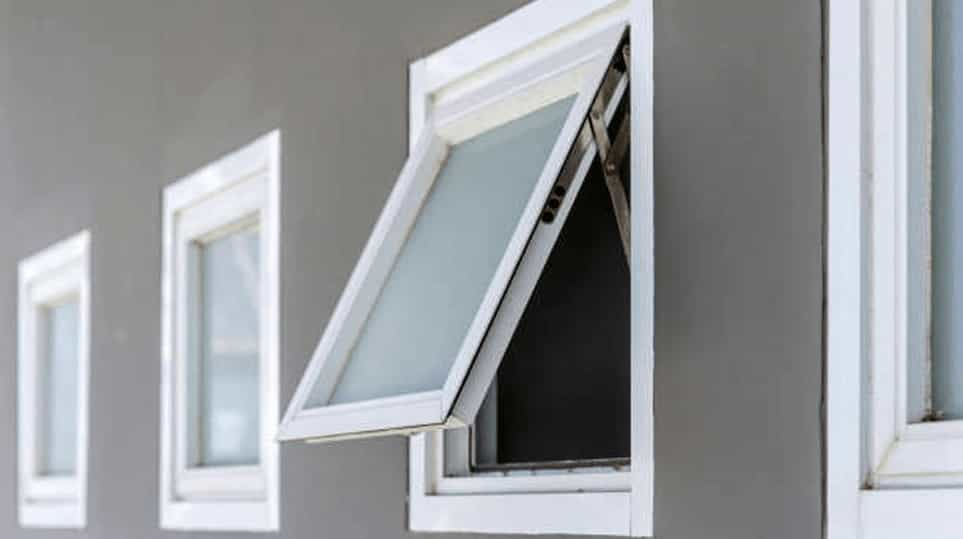Why Choose uPVC Awning Windows?
uPVC awning windows offer unique advantages over casement windows, especially for homes that prioritize ventilation and weather protection. Awning windows open outward from the bottom, creating a natural rain barrier while allowing air to circulate freely. This makes them ideal for rainy climates or rooms that need continuous airflow without outdoor exposure. Unlike casement windows, which swing open fully, awning windows maintain partial coverage, adding security and privacy while still letting in fresh air.
Key Features of uPVC Awning Windows

1. Glazing Options for Customizable Insulation
- Single Glazed: Best for regions with mild weather where minimal insulation is needed. Single-glazed uPVC awning windows offer basic energy efficiency and noise reduction, making them suitable for moderate climates.
- Double Glazed: Popular for energy efficiency, double-glazed uPVC windows consist of two glass panes separated by an air or gas layer. They offer better insulation, noise reduction, and energy savings, making them ideal for temperate climates.
- Triple Glazed: Designed for extreme climates, triple-glazed uPVC windows provide optimal thermal insulation and noise reduction. With three glass layers, they perform well in regions with intense heat or cold.
2. Weather Resistance and Sealed Design
- The unique outward-opening mechanism of uPVC awning windows creates a natural weather barrier. They effectively keep out rain and wind while maintaining good air circulation.
- When closed, these windows seal tightly, providing excellent insulation against noise and external temperatures, making them highly energy-efficient and weather-resistant.
3. Grills for Security and Design Options
- Windows with Grills: Adding grills enhances security, especially in ground-floor installations or high-traffic areas. Grills can also add to the aesthetic, maintaining visibility and airflow.
- Windows without Grills: Grill-free uPVC windows offer unobstructed views and a streamlined look, suitable for upper-level installations or rooms with minimal security concerns.
Suitable and Unsuitable Climates for uPVC Awning Windows
Suitable Climates
uPVC awning windows perform exceptionally well in humid and rainy climates due to their rain-shedding design. They are ideal for tropical and moderate climates, where good ventilation is essential to maintain comfortable indoor air quality. In colder climates, double or triple glazing enhances their thermal insulation, making them an excellent choice for energy savings.
Unsuitable Climates
These windows are generally not recommended for high-wind areas or places with heavy snow. The outward-opening design may be obstructed by snow accumulation, which could impede functionality and performance.
Ideal Locations for uPVC Awning Windows in the Home
1. Bathrooms and Kitchens
Bathrooms and kitchens benefit greatly from uPVC awning windows as they provide airflow while keeping out rain and humidity. The design offers ventilation without sacrificing privacy.
2. Living Rooms and Bedrooms
Awning windows can be installed higher on walls, allowing natural light and air circulation while maintaining privacy. They work well alongside other window styles or above fixed windows for extra ventilation.
3. Basement or Ground-Floor Installations
uPVC awning windows are a good choice for ground-floor installations where security and airflow are essential. Adding grills and robust locks can enhance security, allowing safe ventilation.
Precautions for Ground-Floor uPVC Awning Window Installation
When installing uPVC awning windows on the ground floor, it’s essential to ensure they are fitted with sturdy locks and, if necessary, durable grills. Choose tempered or laminated glass for added security, as these materials are harder to break. Additionally, make sure the window’s opening range is limited to prevent easy access from outside. Regular lock maintenance is also advised, especially in high-humidity areas, to keep mechanisms functioning smoothly.
How to Order a uPVC Awning Window

Step 1: Determine Specifications
- Measure the window space accurately, including width, height, and desired frame color.
- Decide on glazing based on local climate (single, double, or triple glazing).
- Choose additional features like grills, insect screens, and frame finishes.
Step 2: Consult with a Supplier
- Contact a reliable uPVC window supplier to discuss specifications and customization options.
- Request an estimate and discuss warranties for glazing, frame durability, and installation.
- Inquire about add-on features like child safety locks, noise reduction glazing, and UV-resistant coatings.
Step 3: Place the Order and Schedule Installation
- Confirm the details and budget with the supplier, then place the order.
- Schedule a professional installation to ensure a precise fit and alignment, maximizing functionality and energy efficiency.
Additional Benefits of uPVC Awning Windows
- Enhanced Indoor Air Quality: Awning windows provide continuous airflow, improving indoor air quality by reducing indoor pollutants and humidity.
- Privacy and Security: Due to their high placement, uPVC awning windows offer privacy while allowing secure ventilation, making them ideal for bedrooms and bathrooms.
- Low Maintenance: uPVC material is resistant to corrosion, weathering, and fading, requiring minimal upkeep to retain appearance and functionality over time.
uPVC awning windows are an excellent choice for homeowners seeking durable, energy-efficient, and aesthetically pleasing window solutions. With various glazing options and customizable features like grills and finishes, they adapt to diverse climates and architectural needs. Following the outlined steps for ordering and installation ensures you’ll enjoy long-term benefits of these resilient, low-maintenance windows, enhancing comfort and style in your home.

